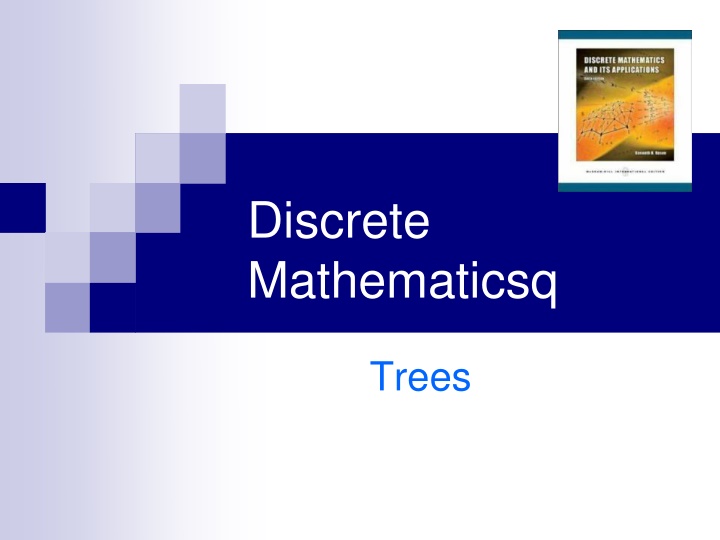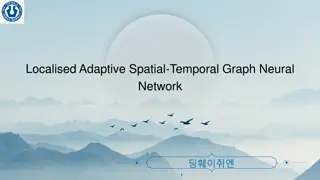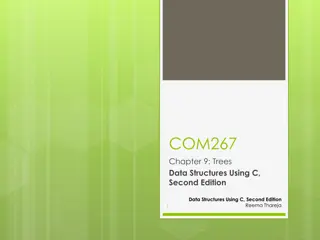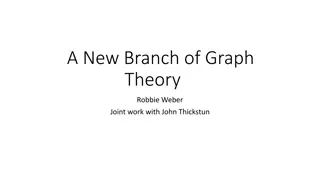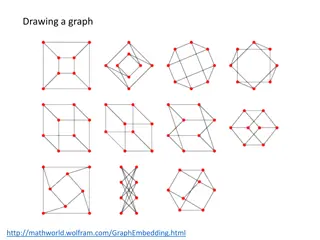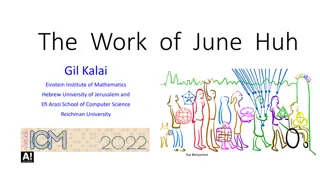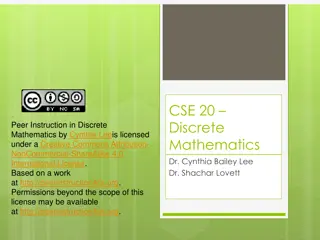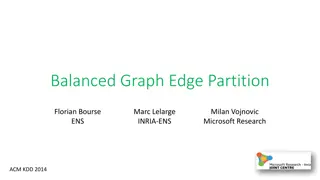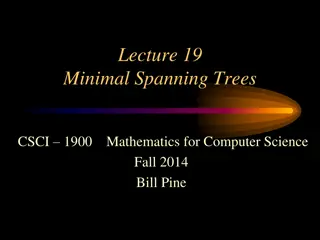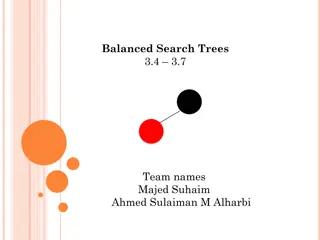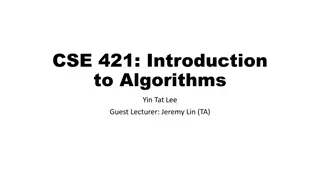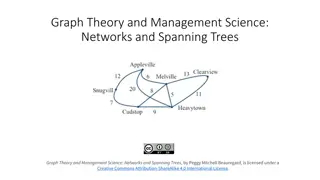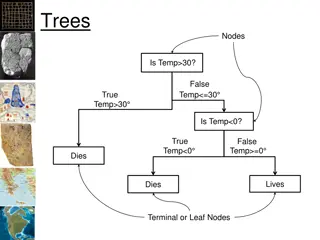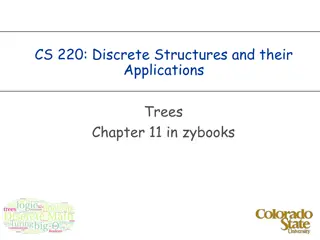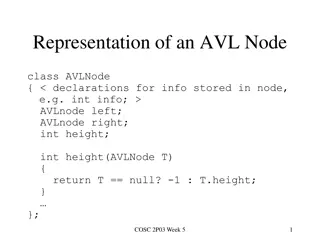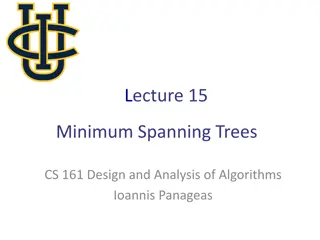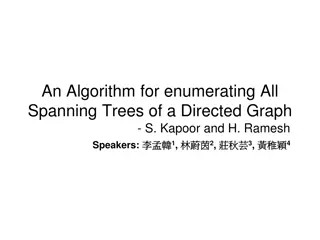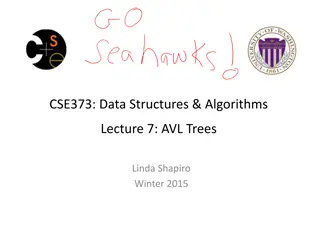Discrete Mathematics: Trees in Graph Theory
In this content, you will explore the concept of trees in graph theory, covering topics such as tree introduction, applications, traversal, spanning trees, and minimal spanning trees. Definitions, theorems, and properties of trees are discussed, providing a comprehensive understanding of rooted trees, parent-child relationships, levels, and heights in trees. The importance of spanning trees in simple graphs is highlighted. Dive into the world of discrete mathematics and understand the fundamental role of trees in graph theory.
Download Presentation

Please find below an Image/Link to download the presentation.
The content on the website is provided AS IS for your information and personal use only. It may not be sold, licensed, or shared on other websites without obtaining consent from the author.If you encounter any issues during the download, it is possible that the publisher has removed the file from their server.
You are allowed to download the files provided on this website for personal or commercial use, subject to the condition that they are used lawfully. All files are the property of their respective owners.
The content on the website is provided AS IS for your information and personal use only. It may not be sold, licensed, or shared on other websites without obtaining consent from the author.
E N D
Presentation Transcript
Discrete Mathematicsq Trees
Outline 10.1 Introduction to Trees 10.2 Applications of Trees 10.3 Tree Traversal 10.4 Spanning Trees 10.5 Minimal Spanning Trees Ch10-2
10.1 Introduction to Trees Def 1 A tree is a connected undirected graph with no simple circuits. Example 1. Which of the graphs are trees? Sol: G1, G2 Note. connected forest Ch10-3
Thm 1. Any undirected graph is a tree if and only if there is a unique simple path between any two of its vertices. Def 2. A rooted tree is a tree in which one vertex has been designed as the root and every edge is directed away from the root. Example Ch10-4
Def: a is the parent of b, b is the child of a, c, d, e are siblings, a, b, d are ancestors of f c, d, e, f, g are descendants of b c, e, f, g are leaves of the tree (deg=1) a, b, d are internal vertices of the tree (at least one child) subtree with d as its root: a b d c e g f d g f Ch10-5
Def: a b c left child of a f d e right child of c left subtree of a right subtree of a Ch10-6
Properties of Trees Thm 2. A tree with n vertices has n 1 edges. Pf. (by induction on n) n = 1 : K1is the only tree of order 1, |E(K1)| = 0. ok! Assume the result is true for every trees of order n = k. Let T be a tree of order n = k+1, v be a leaf of T, and w be the parent of v. Let T be the tree T {v}. |V(T )| = k, and |E(T )| = k 1 by the induction hypothesis. |E(T)| = k By induction, the result is true for all trees. # Ch10-7
Def: The level of a vertex v in a rooted tree is the length of the unique path from the root to this vertex. The level of the root is defined to be zero. The height of a rooted tree is the maximum of the levels of vertices. Example 10. level 0 1 height = 4 2 3 4 Ch10-8
10.4 Spanning Trees Introduction Def. Let G be a simple graph. A spanning tree of G is a subgraph of G that is a tree containing every vertex of G. Example 1 Find a spanning tree of G. Sol. Remove an edge from any circuit. (repeat until no circuit exists) Ch10-9
Four spanning trees of G: Exercise : 1, 8, 11 Thm 1 A simple graph is connected if and only if it has a spanning tree. Exercise : 24, 25 Ch10-10
Depth-First Search (DFS) Example 3 Use depth-first search to find a spanning tree for the graph. Sol. (arbitrarily start with the vertex f) Ch10-11
The edges selected by DFS of a graph are called tree edges. All other edges of the graph must connect a vertex to an ancestor or descendant of this vertex in the tree. These edges are called back edges. Example 4 The tree edges (red) and back edges (black) Ch10-12
Algorithm 1 (Depth-First Search) Procedure DFS(G: connected graph with vertices v1, v2, , vn) T := tree consisting only of the vertex v1 visit(v1) procedure visit(v: vertex of G) for each vertex w adjacent to v and not yet in T begin add vertex w and edge {v, w} to T visit(w) end Exercise : 13 Ch10-13
Breadth-First Search (BFS) Example 5 Use breadth-first search to find a spanning tree for the graph. Sol. (arbitrarily start with the vertex e) Ch10-14
Algorithm 2 (Breadth-First Search) Procedure BFS(G: connected graph with vertices v1, v2, , vn) T := tree consisting only of vertex v1 L := empty list put v1in the list L of unprocessed vertices while L is not empty begin remove the first vertex v from L for each neighbor w of v if w is not in L and not in T then begin add w to the end of the list L add w and edge {v, w} to T end end Exercise : 16 Ch10-15
Backtracking Applications There are problems that can be solved only by performing an exhaustive search of all possible solutions. Decision tree: each internal vertex represents a decision, and each leaf is a possible solution. To find a solution via backtracking: decision tree root decision leaf leaf solution parent Ch10-16
Example 6 (Graph Colorings) How can backtracking be used to decide whether the following graph can be colored using 3 colors? Sol. Ch10-17
Example 7 (The n-Queens Problem) The n-queens problem asks how n queens can be placed on an n n chessboard so that no two queens can attack on another. How can backtracking be used to solve the n-queens problem. Sol. n=4 3rd column Ch10-18
Depth-First Search in Directed Graphs Example 9 What is the output of DFS given the graph G? Sol. Ch10-19
10.5 Minimum Spanning Trees G: connected weighted graph (each edge has an weight 0) Def. minimum spanning tree of G: a spanning tree of G with smallest sum of weights of its edges. Algorithms for Minimum Spanning Trees Algorithm 1 (Prim s Algorithm) Procedure Prim(G: connected weighted undirected graph with n vertices) T := a minimum-weight edge for i := 1 to n 2 begin e := an edge of minimum weight incident to a vertex in T and not forming a simple circuit in T if added to T T := T with e added end {T is a minimum spanning tree of G} Ch10-20
Example 2 Use Prims algorithm to find a minimum spanning tree of G. Sol. (tree) Exercise: 3 Ch10-21
Algorithm 2 (Kruskal Algorithm) Procedure Kruskal(G: connected weighted undirected graph with n vertices) T := empty graph for i := 1 to n 1 begin e := any edge in G with smallest weight that does not form a simple circuit when added to T T := T with e added end {T is a minimum spanning tree of G} Ch10-22
Example 3 Use Kruskal algorithm to find a minimum spanning tree of G. Sol. Exercise: 7 Ch10-23
